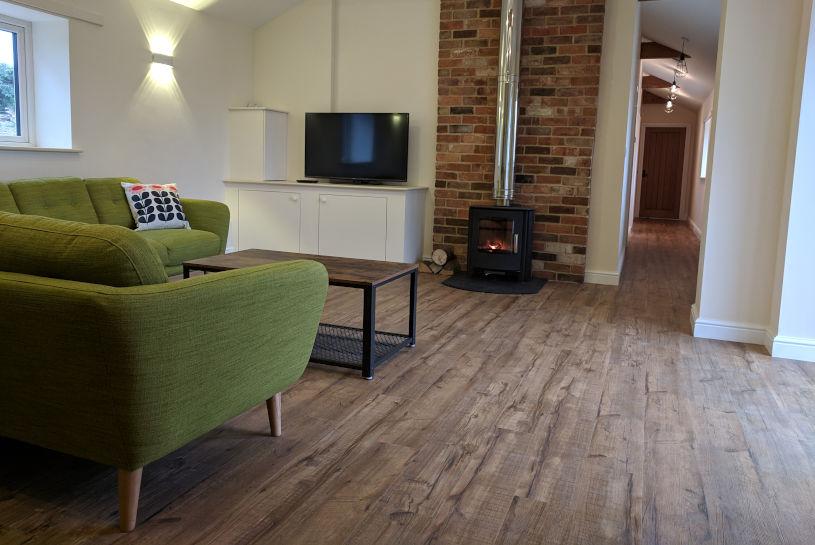
People often call vinyl flooring lino by mistake, thinking they are the same thing. Here, Floors for Paws looks at the differences between these two popular flooring solutions.
What is lino?
Lino, or linoleum to give it its correct name, is a type of flooring that was particularly popular in the first half of the 20th century. Invented by Frederick Walton in the mid-1800s, lino is a mixture of linseed oil (hence the name linoleum) with natural materials such as cork dust or wood pulp, and pigments. In terms of maintenance, a lino floor needs to be recoated and waxed every year.
Vinyl flooring
In contrast to lino, vinyl flooring is made from a completely synthetic, manmade material, called PVC (polyvinyl chloride plastic). Vinyl flooring consists of multiple layers that are heated and pressed together. The surface layer gives the flooring its final appearance and is coated for resistance to scratches, liquids and stains.
How to buy vinyl flooring
Where linoleum can only be bought on the roll (like rolls of carpet), vinyl flooring is available on the roll as well as luxury vinyl tiles or luxury vinyl planks. This gives users the opportunity to create patterns in their flooring such as the traditional herringbone pattern of parquet floors.
At Floors for Paws, our ethos has always been to put the welfare of dogs on an equal basis to that of their owners. To this end, we have worked extensively with Canine Arthritis Management to develop a range of flooring that is the best flooring for dogs. So how does lino measure up to vinyl flooring when it comes to our pets? Let’s take a look at the features of the best flooring for dogs which include slip resistance, comfort, water resistance, and low maintenance in order to keep dogs and their owners happy.
Comfort
The multi-layer composition of vinyl flooring allows for a soft, comfort layer to offer cushioning to older dogs. As linoleum is a single layer construction, this is lacking and may be hard for dogs with joint conditions to lie down on for extended periods.
Slip resistance
Linoleum is extremely slippery and requires an application of a water based sealant or modified resin solution. However it can take up four applications before some slip resistance is achieved. Floors for Paws’ Pawsafe Domestic range and Luxury Vinyl range on the other hand, have the highest slip rating of any vinyl plank flooring currently on the market
Water resistance
With dogs at either end of the age spectrum being prone to accidents (either from not yet being house-trained or from suffering from age-related incontinence) water resistance is important for dog owners. Linoleum requires regular sealing in order for it to be water resistant and even then, it isn’t recommended for any areas that are prone to moisture and humidity. Vinyl flooring however, when professionally installed is completely waterproof.
Maintenance
Both linoleum and vinyl are fairly easy to clean but keeping pet-friendly flooring clean is easier with vinyl flooring. It requires the minimum of ongoing maintenance beyond regular sweeping and mopping with plain warm water. Linoleum on the other hand does not stand up well to being mopped and does need to be sealed once or twice a year.
Comparisons between vinyl flooring and linoleum
Aesthetics – The options available or vinyl flooring are extensive. As the final aesthetic of LVT flooring and luxury vinyl planks depends on the pattern printed onto their surface layer, colours and patterns available are extensive and wood-, stone-effect finishes are also possible. Linoleum undergoes a different process, with the pigment added to the natural materials in the flooring. This limits the choice of pattern available.
Durability – as lino is a softer material than vinyl, it is more susceptible to scratches and damage. Its single layer composition means that regular sealing is required to counteract this, where vinyl flooring has an integral scratch resistant layer.
Installation – both require experienced installers if they are to give a maximum lifespan and durability. While vinyl is much beloved by the enthusiastic DIY-er, at Floors for Paws we are able to offer a prolonged guarantee against damage or failure of the flooring if it has been professionally installed.
Sustainability – as a product made using only natural materials, lino is completely organic and therefore sustainable, whereas vinyl flooring has, over the years, received a fair amount of bad press due to the nature of its manufacture and the lack of opportunity for recycling. At Floors for Paws, we use efficient manufacturing processes and our ranges are chemical free with a low VOC count. Floors for Paws is both FloorScore® and DIBt certified for superior indoor air quality, and our products are manufactured to ISO 9001 and ISO 14001 standards. We use only recyclable plastic and only recommend a solvent-free adhesive.
While linoleum can be described as the precursor to vinyl, it’s fair to say that the invention of vinyl flooring definitely sounded the death knell for lino. It is however, experiencing a small comeback but for dog owners, we believe that vinyl flooring is the best flooring for dogs. If you would like to discuss any of our vinyl flooring ranges, please send us an email to info@floorsforpaws.com or give us a call on 01522 300218

